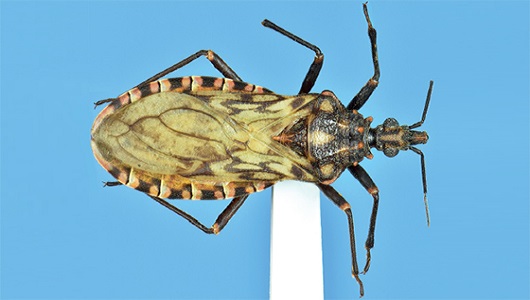Researchers find new species of ‘kissing bug’, vector of Chagas disease
24/06/2022
Max Gomes (IOC/Fiocruz)
A new species of triatomine bugs, a subfamily of insects commonly known as ‘kissing bugs’, has been described by a group led by researchers of the Oswaldo Cruz Institute (IOC/Fiocruz). Christened Panstrongylus noireaui, the species belongs to a genus of high medical relevance due to its participation in the transmission of the Trypanosoma cruzi protozoan, which causes Chagas disease, in Central and South America. The finding was published in ZooKeys, which focuses on the description of new species and taxonomic analysis.
The Panstrongylus noireaui (image: IOC/Fiocruz)
The identification took place after a study by the University of the Republic of Uruguay noticed differences in chromosomic and molecular analysis of specimens that had, until then, been defined as belonging to another population of "kissing bugs", Panstrongylus rufotuberculatus. The paper, published in the Memórias do Instituto Oswaldo Cruz magazine, suggested that the analyzed specimens could be a new species of the Panstrongylus genus.
“Perception by means of chromosomic and molecular analysis was crucial, as the external differences between P. noireaui and P. rufotuberculatus are minimal. On the other hand, their DNAs have a series of remarkable characteristics that not only differentiate one species from another, but that also make P. noireaui much more singular within its genus”, explained Cleber Galvão, last author of the study and chief of the National and International Reference Laboratory for Triatomine Taxonomy of the IOC.
A more detailed morphological exam showed a small distinction in the genitalia of male specimens of P. noireaui, reinforcing the hypothesis that this was a new species, morphologically and evolutionarily very close to P. rufotuberculatus. “We can say they are sister species, which at some point had a common ancestor. The only observable morphological difference lies in the denticles of the endosome, a membrane present within the male genitalia. As this is not a feature easy to spot, the specimens had to be dissected”, said the researcher.
The following scientists also participated in the identification: Hélcio Reinaldo Gil Santana, of the IOC’s Diptera Laboratory, Tamara Chavez, of the National Institute of Health Laboratories of Bolivia, and Sebastián Pita and Francisco Panzera, both from the University of the Republic of Uruguay.
Acknowledged collaboration
The new species was named Panstrongylus noireaui after French researcher François Noireau, who passed away in 2011. Noireau worked as a professor at the Institut de Recherche Pour Le Développement in France, and collaborated in different activities within the area of entomology of the IOC.
“Together with the teams from Bolivia and Uruguay, people who also knew him and admired him, we decided to celebrate him this way. François gave significant contributions to fieldwork here in Latin America. He worked for almost a decade in our lab as a visiting researcher and was part of several collaborations”, said Galvão. “This species was originally found in Bolivia and he was very attached to that country, where he also lived for many years. We believe this is a beautiful tribute”, he concluded.
The type specimens used to characterize P. noireaui come from the region of La Paz, in Bolivia, and were collected in 2004. They are currently deposited at the IOC’s Collection of Triatomines, under the responsibility of the National and International Reference Laboratory of Triatomine Taxonomy of the Institute. The collection is home to more than 9,000 dry specimens of triatomines and other reduviids.




